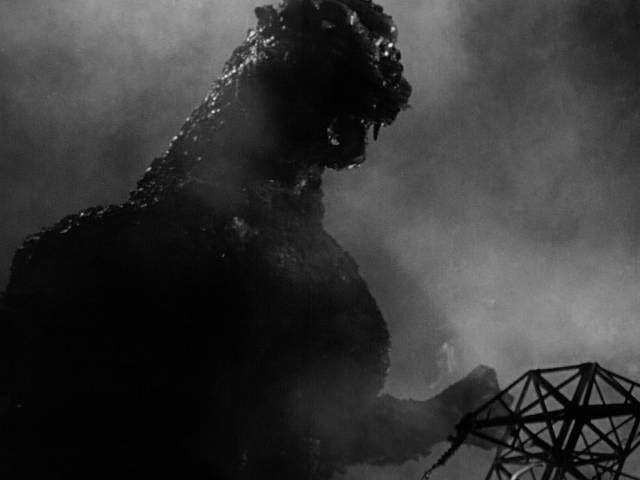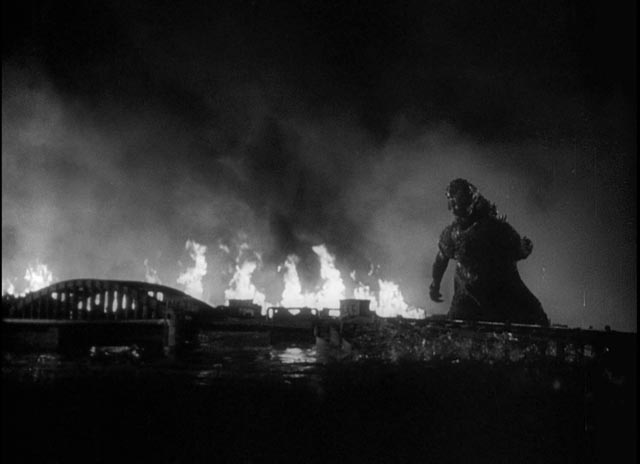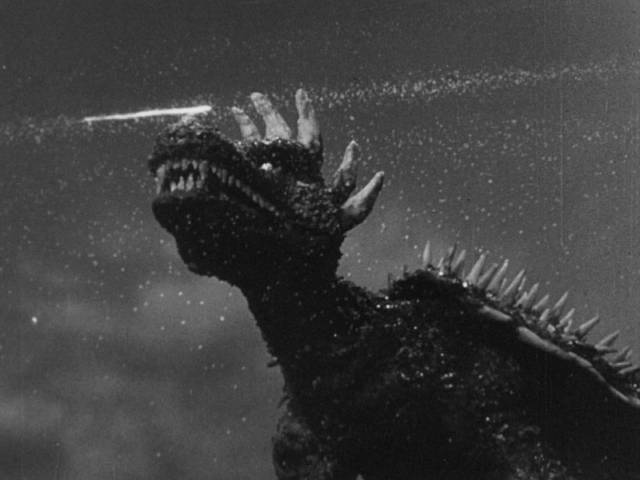Two Godzilla novellas by Shigeru Kayama

Godzilla and Godzilla Raids Again
by Shigeru Kayama (translated by Jeffrey Angles)
University of Minnesota Press, 2023
Godzilla has been so deeply embedded in popular culture for the past seven decades that the big, destructive reptile is now viewed with more affection than horror. After almost forty movies – with the latest, Takashi Yamazaki’s Godzilla Minus One, due for release in December – his reappearance is awaited like the visit of an old friend. But back in 1954 he stood clearly as a metaphor for the destruction wrought on Japan in the closing days of World War Two, the atomic bombing of Hiroshima and Nagasaki, but also the devastating fire-bombing of Tokyo in the Spring of 1945. The wreckage left by Godzilla’s rampage was a chilling reminder of what many Japanese had witnessed less than a decade before, a connection reinforced by the monster’s having been awoken by then-recent American bomb tests in the Pacific. While Godzilla evolved into a kind of kid-friendly camp in subsequent appearances through the ’50s, ’60s and ’70s, he initially represented the mass destruction of modern warfare and a warning of the dangers of building ever more powerful weapons.
The original impetus for the project was producer Tomoyuki Tanaka’s reading of news reports about the fate of the Japanese fishing vessel Lucky Dragon 7, which had been caught downwind of a hydrogen bomb test; the crew had received devastating radiation contamination which seemed like an extension of the lingering consequences of the 1945 bombings. Those tests also produced contamination of fish stocks, which reinforced the idea that the effects of modern warfare went far beyond the moment of immediate destruction. These unsettling events led Tanaka to commission science fiction author Shigeru Kayama to draft a story on which to base an epic movie.
That story drew on the recent success of Eugène Lourié and Ray Harryhausen’s The Beast from 20,000 Fathoms (1953) and the classic King Kong (1933) for structural and plot details, but relocating them to the specific historical context of post-war Japan gave them additional dramatic power. If Kayama’s name has been little known in the West, that’s largely because the original film is so indelibly associated with director Ishiro Honda (who adapted Kayama’s story into a screenplay with writer Takeo Murata) and special effects creator Eiji Tsuburaya.
While the story of the film’s production, commercial success and critical reception is now well-known, an interesting sidelight has been provided by the University of Minnesota Press’s recent publication of the first English translation of two novellas by Kayama, originally published in 1955 around the time of the release of the first Godzilla sequel, Godzilla Raids Again (1955). Written for a young adult readership, these aren’t Kayama’s original treatments, but rather novelizations based on the films. From an academic point of view, it might have been valuable to publish the treatments alongside these hybrid stories, which apparently contain echoes of Kayama’s intentions blended with changes made by Honda and Murata.

There are differences between the published stories and the movies themselves, but the broad outlines and themes remain essentially the same. Given the limited length – the first story, Godzilla: Godzilla in Tokyo, is just over 100 pages; the second, Godzilla Raids Again: Godzilla in Osaka just 75 pages – the familiar narratives aren’t expanded or given more depth, but there are differences in emphasis. The nominal protagonist of the first film, salvage-ship captain Ogata, who’s engaged to Professor Yamane’s daughter Emiko, is somewhat displaced, while the younger Shinkichi becomes more of a reader-identification character, a young man from Odo Island connected both to the emergence of Godzilla – members of his family die during the monster’s first attack – and also to Emiko since they met as children when she was evacuated to the island during the war. By reducing the Ogata-Emiko subplot, Kayama shifts attention more decisively to the moral conflict within Emiko’s friendship with embittered scientist Serizawa, who has been working in secret on a devastating new weapon.
Serizawa and paleontologist Yamane provide variations on the question of scientists’ responsibility for the consequences of their work. Despite the devastation caused by Godzilla’s increasingly ferocious attacks, Yamane is against destroying the beast – we could learn much from him and perhaps his very indestructibility offers valuable clues to beneficial medical breakthroughs. As for Serizawa, despite the recent devastation of Japan during the war he is following his research into dangerous areas simply because he’s curious about what he can achieve despite knowing that politicians and the military could use his work to wreak terrible harm on other countries. Although their ends seem diametrically opposed – Yamane’s might result in benefits, Serizawa’s can only lead to horror – both disregard the more immediate impact on human lives.
This is all present in the film. The one new element introduced by Kayama, but unfortunately not fully developed, is the quick appearance of the Tokyo Godzilla Society, seemingly a cult devoted to the creature which spreads fear associated with his appearances. This causes Professor Yamane to question whether the beast is actually an animal at all – perhaps it’s a machine manipulated by the cult to cause the collapse of society? Given his resistance to destroying Godzilla, Yamane himself is suspected of being the cult’s leader. But all this is eventually dropped rather unceremoniously when it turns out the cult was cooked up by a petty criminal hoping to make use of Godzilla’s attacks to extort money from frightened people.
The story concludes just like the film, with Serizawa finally persuaded to use his devastating weapon to destroy Godzilla, committing suicide as he does so in order to bury the secret of his invention so that it can never be used for nefarious purposes. But the potential of science to bring destruction remains a constant, with continuing bomb tests likely to give rise to other threats like Godzilla.

The sequel, like the movie it was based on, lacks the power of the original. The film was rushed out to cash in on the first film’s success and like many sequels could do little more than repeat what the filmmakers saw as the most profitable elements – in this case, naturally, that was the monster mayhem. A new test awakens a new Godzilla, which once again attacks the Japanese mainland, though it picks a different city. To spice things up, a second creature is also awoken, Anguirus, which seems very hostile to Godzilla, provoking even more destruction as the pair engage in combat in the middle of Osaka. This was the beginning of Godzilla’s descent from grim metaphor to kids’ fantasy.
Both novellas seem like sketches for larger works – reflecting their origins in film treatments. More often than not, ideas for scenes are strung together rather than fully developed. Apparently relying on readers’ familiarity with the movies, Kayama doesn’t even bother to provide any description of Godzilla other than vague references to his scale and the destructive power of his massive tail and his atomic breath. One detail not explicit in the films is that he grabs and eats people (and farm animals). Little depth is given to the characters and their relationships beyond the subplot involving Emiko and Serizawa, while whole pages of the second story are given over to tedious banter between pilots Kobayashi and Tsukioka about their quest to find girlfriends. No doubt this is intended to provide a human counterpoint to the destruction of Osaka, but it merely distracts from the rather meagre narrative.
But if Kayama is weak on character and dramatic scenes, he does manage to evoke the horror of the destruction wrought by the monsters, with descriptions which raise memories of the images of cities devastated by the recent war. Here, words on the page have a more sombre impact than the impressive effects created by Eiji Tsuburaya on screen, where the visual spectacle of destruction produces a paradoxical sense of excitement.
Accompanying the stories, translator Jeffrey Angles provides a lengthy essay about Kayama’s role and the larger context out of which Godzilla emerged. This, along with the two stories, provides an interesting footnote to the seventy-year history of Godzilla. Although the stories don’t offer anything to alter our perception of that history, they do restore Shigeru Kayama to his rightful place alongside Ishiro Honda, Tomoyuki Tanaka, Takeo Murata and Eiji Tsuburaya as one of the key creators of a modern cultural icon.
Comments